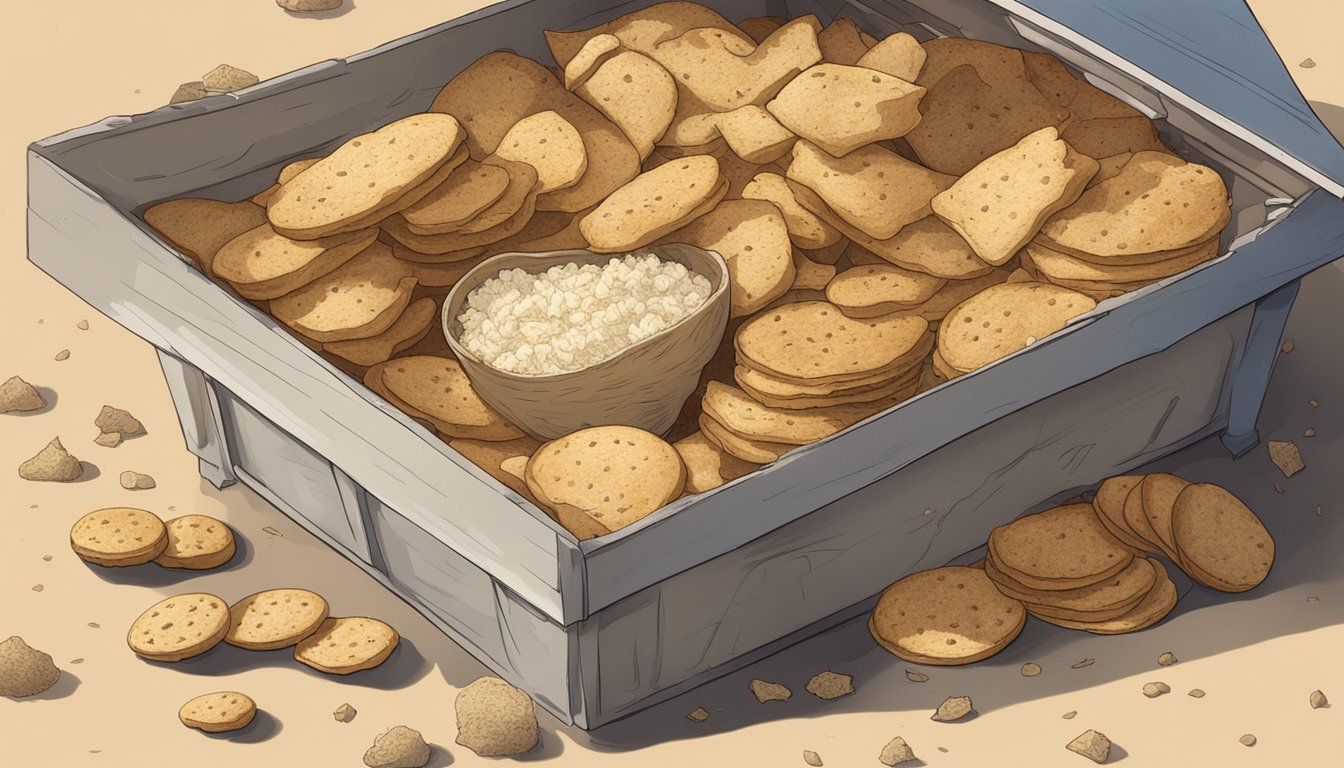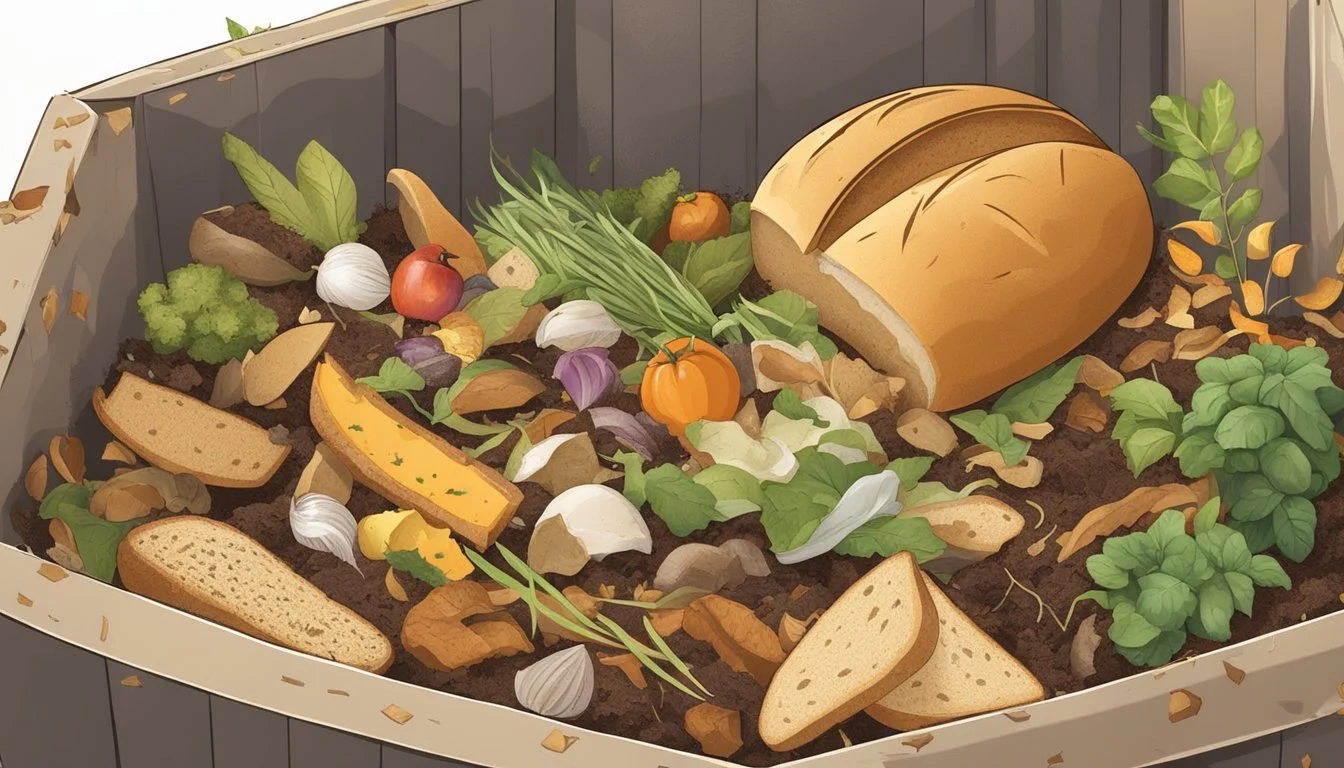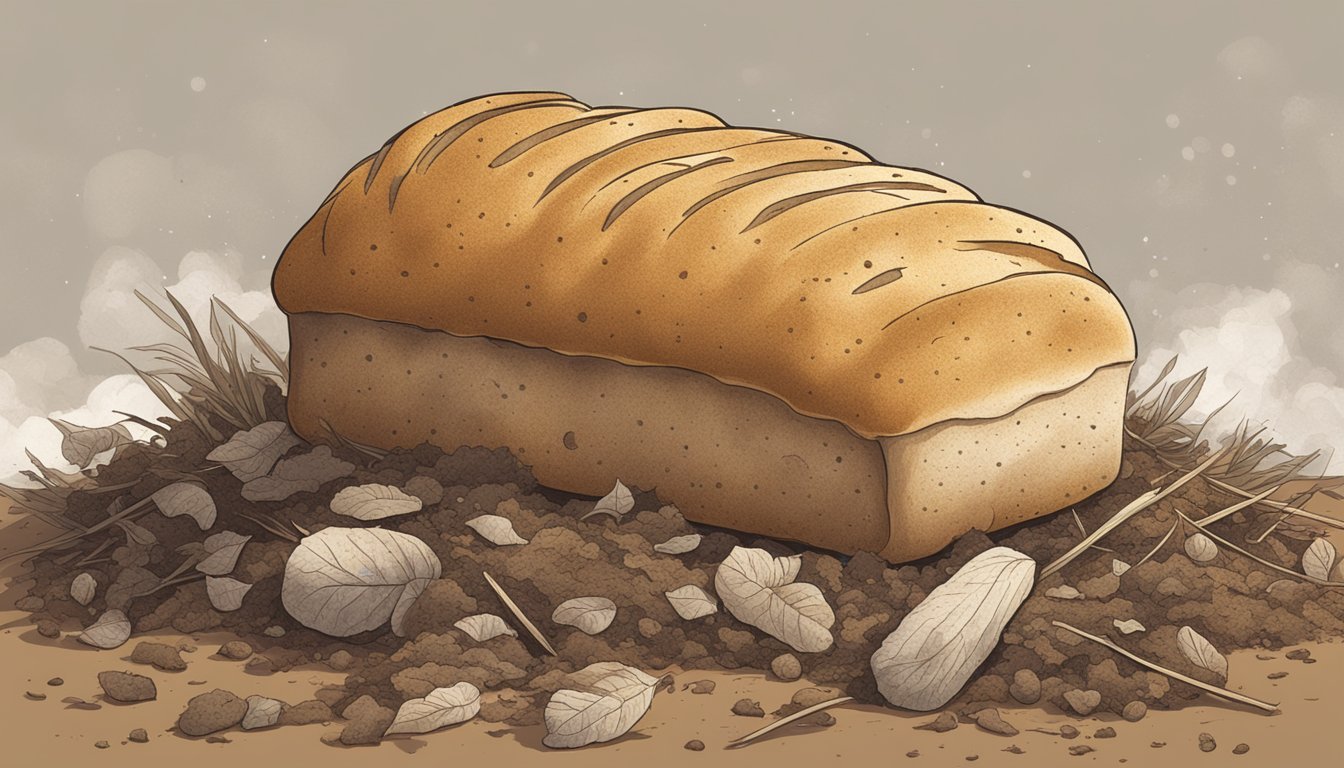Can You Compost Bread?
Unveiling the Dos and Don'ts
When it comes to composting, bread (What wine goes well with bread?) is often a subject of controversy. While some gardeners may hesitate to add bread to their compost piles due to concerns over attracting pests, others incorporate it without issue. The truth is, bread can be composted as it is an organic material that will decompose over time. However, the process must be handled carefully to minimize the risk of attracting unwanted animals and to ensure that it contributes positively to the compost.
Bread consists of organic matter and is considered a green compost material, which means it is rich in nitrogen. Nitrogen is a crucial element in the composting process, helping to break down carbon-rich materials known as 'browns'. When composting bread, it is recommended to balance it with these brown elements and to ensure that the bread is mixed in thoroughly with the compost. Properly maintained, a compost bin with bread can lead to a nutritious soil amendment without the drawbacks that concern some gardeners.
Understanding Composting
Composting is a biological process that decomposes organic matter, transforming waste materials into a valuable soil amendment. It involves a delicate balance of green and brown materials, the right environment for microorganisms, and appropriate methods for optimal decomposition.
Basics of Composting
Composting requires three basic ingredients: green materials for nitrogen, brown materials for carbon, and water to maintain moisture. Nitrogen-rich greens, such as vegetable scraps or grass clippings, provide resources for microorganisms to grow and reproduce. Carbon-rich browns, like dried leaves or cardboard, offer energy for the decomposers. A balanced mix of these materials, along with proper moisture and aeration, is critical for successful composting.
Green and Brown Materials
In composting, green materials are often kitchen scraps, fresh plant material, and coffee grounds. These are high in nitrogen and are quick to decompose. Brown materials, on the other hand, are dry items like straw, dead leaves, and branches, which are high in carbon. The ideal ratio is about 3-parts brown to 1-part green. This helps maintain the necessary balance for efficient decomposition.
Composting Methods
Various methods can be applied to compost, each with its own set of protocols. Some common techniques include piles, bins, tumblers, and vermicomposting. Piles and bins are simple methods, while tumblers speed up the process by easily turning the compost. Vermicomposting uses worms to enhance decomposition. A key factor in all methods is maintaining proper temperature and oxygen levels to support the active microorganisms responsible for breaking down the organic matter.
The Role of Microorganisms in Composting
Microorganisms play the pivotal role in composting. These tiny decomposers, including bacteria, fungi, and protozoa, break down organic matter into simpler substances. Their activity generates heat, which raises the compost's temperature and speeds up the process. Proper aeration of the compost pile ensures these organisms have enough oxygen to remain efficient, while excessive moisture can create an anaerobic environment, slowing down decomposition.
Can You Compost Bread?
Composting bread is a topic that often arises when discussing the breakdown of organic matter. While bread is indeed compostable, there are important considerations to take into account.
Pros and Cons of Composting Bread
Pros:
Nutrient Addition: Bread contributes to the nitrogen content in compost, aiding the decomposition process.
Waste Reduction: Composting bread prevents it from contributing to food waste in landfills.
Cons:
Pest Attraction: Bread can attract rodents and insects if not properly managed.
Mold Growth: As bread decomposes, it can foster mold growth, which might not be desirable for your compost.
Concerns with Bread in Compost
Pest Management: Securing compost bins or using a compost pit cover is essential to deter pests when composting bread.
Mold Control: Bread should be buried deep within the compost pile to minimize exposure and control mold development.
Balanced Composition: Ensure bread is part of a balanced compost mix, including enough 'browns' – carbon-rich materials like leaves and cardboard – to avoid a nitrogen-heavy and potentially smelly compost pile.
Preventing Problems When Composting Bread
When adding bread to compost, one must be strategic to prevent issues like pest attraction, mold growth, and nutrient imbalance. Specific measures can ensure the composting process remains effective and hygienic.
Avoiding Pests and Rodents
To avoid attracting pests and rodents to the compost pile, one should:
Crumble bread: Break bread into small pieces to accelerate decomposition.
Bury the bread: Place bread deep within the compost to make it less accessible.
Secure the compost: Use bins with tight-fitting lids or covers such as metal or cardboard.
Controlling Mold and Disease
To control mold and disease within a compost pile, it is essential to:
Monitor moisture: Ensure the compost has a balanced moisture level, not too wet or dry.
Turn the pile regularly: This introduces oxygen and helps keep the temperature high enough to discourage mold growth.
Maintaining Proper Compost Balance
For maintaining a healthy balance in compost:
Correct ratio of greens and browns: Aim for a mix of high-nitrogen content ("greens" like bread) and carbon-rich materials ("browns") to maintain balance.
Add bread sparingly: Incorporate bread as a small part of the overall compost to avoid overwhelming the system with nitrogen.
Composting Bread Alternatives
When considering bread for compost, one must distinguish between directly composting bread and exploring compostable alternatives. Here's how one can utilize stale or moldy bread and what other compostable options are available as substitutes.
Using Stale or Moldy Bread
Stale and moldy bread can be beneficial for composting due to their nitrogen content, an essential element required for compost's success. Stale bread, when dry and hard, is less likely to attract pests than fresher bread. It should be broken into small pieces and moistened if necessary before adding to the compost pile to accelerate decomposition. Moldy bread has already started the decomposition process, which can potentially aid in the composting process. However, it is crucial to bury it deep within the compost to prevent attracting pests and rodents.
Compostable Bread Alternatives
For those cautious about composting bread due to potential pest issues, here are compostable bread alternatives:
Grains and cereals: Non-bread grains like rice or oats serve as excellent compost ingredients when cooked and unsalted.
Crackers and pretzels: These snacks, preferably unsalted and unseasoned, can be added in moderation, similar to stale bread.
Each alternative must be used in balance with other compost materials to maintain the proper carbon-to-nitrogen ratio, ensuring a nutrient-rich and efficient decomposition process.
Incorporating Bread into Your Compost Pile
When composting bread, it essential to consider the quantity added and how it's balanced and layered with other compost materials. Careful management ensures the bread contributes positively to the composting process.
Adding Bread in Small Amounts
Bread, being a green compost material rich in nitrogen, should be added in small pieces to accelerate decomposition. A gardener should introduce bread sparingly to prevent overloading the pile and attracting pests. If a person is composting bread, it's best to break it into small bits and distribute it throughout the compost pile.
Balancing Bread with Other Composts Materials
To maintain a healthy compost pile, bread must be balanced with brown materials such as leaves, sawdust, or straw. These carbon-rich elements offset the nitrogen in bread, helping to regulate moisture and aeration. An individual should aim for a ratio of roughly 30:1 of brown to green materials.
Layering Techniques
Incorporating bread effectively into a compost pile involves layering techniques. One should layer small pieces of bread with brown materials to foster an environment conducive to decomposition. This method not only aids in moisture absorption but also limits the accessibility for pests.
Here is a simple breakdown on how to layer bread with other materials in compost:
Start with a brown layer at the base, like straw or sawdust.
Add a thin layer of bread pieces.
Cover with another layer of brown materials.
Continue alternating layers, ensuring bread is not exposed.
By following these guidelines with confidence and clear understanding, bread can become a valuable addition to a compost pile.
Best Practices for Composting Bread
In composting bread, the focus should be on maintaining the correct environmental conditions, regularly checking compost health, and ensuring that the compost reaches full maturity before use.
Creating the Right Environment
Soil forms the foundation of a healthy composting ecosystem. For bread to decompose effectively, it needs to be buried within a compost bin, surrounded by a mix of green and brown materials. Green compost materials, such as fruit and vegetable scraps, are high in nitrogen and facilitate quick decomposition. Brown materials like dead leaves, straw, or wood chips are rich in carbon, balancing the compost and adding structure.
Monitoring Compost Conditions
Keeping an eye on the moisture level in the compost is crucial, as it should remain similar to the consistency of a wrung-out sponge. If the compost becomes too dry, microbial activity slows, delaying bread decomposition. However, excessive moisture can create anaerobic conditions and lead to unpleasant odors. Regularly turning the compost, possibly with a compost tumbler, helps distribute moisture evenly and introduces oxygen, promoting aerobic decomposition.
Achieving Compost Maturity
To determine when bread and other materials have fully decomposed into finished compost, look for a crumbly texture, an earthy smell, and the absence of any recognizable food particles. Fully matured compost can provide a powerful soil amendment, enriching the soil with beneficial microorganisms and nutrients, enhancing soil structure, and improving plant growth.
Potential Issues with Bread in Compost
When composting bread, it is important to be aware of specific challenges such as attracting unwanted pests and managing the decomposition rate.
Pest Attraction and Infestation
Attracting pests: Bread can attract various animals and insects due to its scent and nutritional content. Insects such as ants and flies, as well as larger animals like rodents, may be drawn to the compost pile if bread is present. The risks of pest infestation increase when bread is not properly managed within the compost.
To mitigate this risk:
Use a secure lid on your compost bin.
Mix bread with carbon-rich materials to mask odors.
Bury bread deeper within the compost to make it less accessible.
Uneven Decomposition Rates
Decomposition rates can vary significantly within a compost pile and bread, especially if left in larger pieces, can decompose at a different rate compared to other organic materials. This can lead to uneven decomposition within the pile, potentially causing odors as the bread molds and rots rather than decomposes efficiently.
Strategies to ensure consistent decomposition:
Crumble leftover bread into smaller pieces to accelerate breakdown.
Balance bread with appropriate amounts of "greens" and "browns" to maintain an optimal bacterial balance.
By addressing these issues, one can maintain a healthy compost environment and effectively recycle leftover bread.
Environmental Impact of Bread Composting
Composting bread can significantly reduce waste sent to landfills and enhance soil health, demonstrating both waste reduction and agricultural benefits.
Reducing Waste and Landfill Contribution
Every year, millions of tons of food waste end up in landfills, contributing to environmental issues like greenhouse gas emissions. Composting bread is a direct action to reduce waste. When individuals opt to compost bread instead of disposing of it in the trash, they contribute to a decline in landfill waste. This diversion of organic material is instrumental in lessening the environmental footprint of waste management.
Key Factors:
Organic waste reduction: Composting bread reduces the volume of organic materials in landfills.
Greenhouse gas minimization: Less organic waste in landfills means lower methane emissions, a potent greenhouse gas.
Advantages for Soil Health and Plant Growth
Composting bread transforms it into nutrient-rich soil, enhancing the quality of garden soil. The nutrients released during the decomposition process are instrumental for soil health and, consequently, for robust plant growth.
Soil Health Benefits:
Increment in nutrient content: Composted bread adds essential nutrients to the soil.
Improvement in soil structure: The incorporation of compost helps to aerate the soil, promoting better water retention and root penetration.
Advantages for Plants:
Richer soil from bread compost can lead to more vigorous plant growth.
Bread compost acts as a slow-release fertilizer, supplying plants with needed nutrients over time.
Alternatives to Composting Bread
When it comes to managing leftover bread, composting is not the sole option. There are efficient and practical alternatives that can prevent waste and contribute value in other areas such as animal feed, soil enrichment, and waste reduction through worm composting.
Feeding Animals with Leftover Bread
One can provide leftover bread as a supplemental feed to animals. Chickens, pigs, and even some wild birds can benefit from bread in small, controlled amounts as part of a balanced diet. However, it is imperative to avoid overfeeding, as bread doesn’t provide the full nutritional profile required for animal health.
Recycling Through Vermicomposting
Leftover bread can also be incorporated into vermicomposting systems. This method involves worms breaking down organic waste, and bread can serve as an occasional food source for them. The key is moderation to prevent mold and pests, ensuring vermicomposting remains an effective recycling process.
Using Bread as a Garden Soil Amendment
Finally, bread can be used directly as a garden soil amendment. By breaking down bread into very small pieces, one can mix it thoroughly into the garden soil, where it slowly decomposes and adds organic matter. This can improve soil structure and fertility when done sparingly to prevent attracting rodents or causing mold issues.
Frequently Asked Questions
This section addresses common queries regarding the composting of bread, diving into the specifics of working with fresh bread, the types suitable for composting, and mold prevention techniques.
Can You Compost Fresh Bread?
Yes, one can compost fresh bread. However, fresh bread should be added in moderation to compost piles as it can attract pests due to its high nitrogen content. To mitigate this risk, it's advised to bury bread deep within the compost pile and balance it with carbon-rich 'brown' materials.
What Types of Bread Are Best for Composting?
When it comes to composting, all types of bread can be composted. This includes white, wheat, and multigrain bread. Ideally, bread that is moldy or stale is better suited for composting, as it breaks down faster and is not as attractive to pests as fresh bread.
How to Prevent Mold When Composting Bread?
To prevent mold growth when adding bread to compost, one should ensure that the compost pile is well aerated and maintain proper moisture levels. Bread should be broken into smaller pieces to aid in quicker decomposition and should be mixed thoroughly with dry, carbon-rich materials to avoid creating mold-friendly environments.
Conclusion
When considering the addition of bread to compost, gardeners can do so with the understanding that it is indeed compostable. Bread breaks down into the soil, releasing nutrients that enrich the garden bed. However, to maintain a healthy composting process, one should remember a few key guidelines.
Bread should be crumbled into small pieces to aid in quicker decomposition.
Including bread should be done sparingly to avoid any imbalance in the compost pile composition.
It's vital to monitor the compost pile for unwanted pests that might be attracted to bread.
In practice, a variety of organic materials should contribute to the compost to ensure a balanced mix of green and brown material. Bread, as part of the green materials, should be balanced with brown materials like dry leaves or twigs to maintain an optimal carbon to nitrogen ratio.
By following these practices, one ensures that their compost remains a productive part of their gardening regimen.






